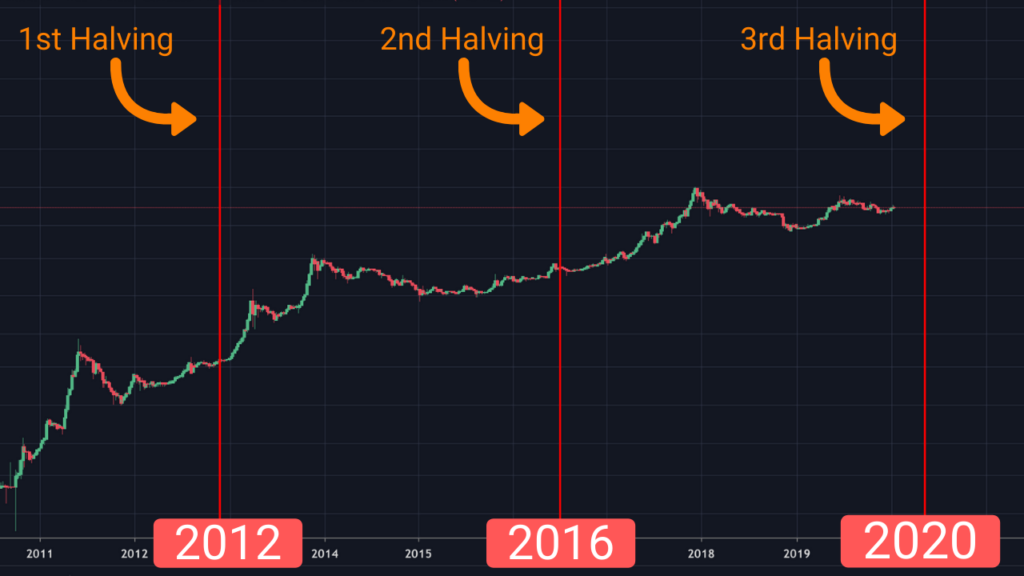Lord777
Professional
- Messages
- 2,579
- Reaction score
- 1,510
- Points
- 113
Halving! Sloppy, but it perfectly captures the essence of what happens to Bitcoin every few years. A small educational program on halving. You should know that for sure!
Introduction
Miners, blockchain, staking, hard fork, and now halving. I know that you are already fed up with all these incomprehensible words. Be patient, buddy, because the global adoption of the crypt is just around the corner. And if you don’t fumble in it, you will have nothing to do in the modern world and the cryptocurrency future, which is about to come. So take your pick. Either you study hard or you are left out.
How does Bitcoin work?
Let's remember the basics. What are miners for? With the help of their computing power, they maintain the smooth operation of the entire blockchain - conducting transactions, creating and signing new blocks. They are rewarded for their work. Some in the form of transaction fees paid by users, and some in the form of new "mined" bitcoins. As we know from the very creation of Bitcoin, it was laid down that there will be a limited number of coins, namely 21 million. That is, there will be only 21 million bitcoins in the world and not a single coin more. If we take a look at the interactive graph, we can see how the number of available coins in the world has increased. In 2010, there were only 3 million coins, and today it is already 18 million coins. But attentive guys noticed that the dynamics of generating new coins has significantly slowed down. All thanks to the same halving.

number of bitcoins
What is halving?
This is a very tricky and practical deflationary program embedded in the bitcoin code. If ordinary coins can be cut in half with a circular saw, everything is done automatically in the blockchain. It was envisioned by the creators of Bitcoin that every 210,000 blocks generated, the reward for closing each block will be halved. (One block is generated approximately every 10 minutes). If at the beginning of the existence of the coin, each block "stood" 50 bitcoins, now only 6.25 coins will be credited to the miners. All thanks to 3 successful halvings that happen about once every 4 years. (in 2012, 2016 and 2020).

Eternal halving?
No, halvings won't happen indefinitely. Nevertheless, we have yet to see more than a dozen of these historical "cuts". According to preliminary calculations, the last bitcoin will be mined already in 2140, when you and I will most likely be gone. What will happen? Well, most likely, until that time, bitcoin will be replaced by something more interesting, and if not, miners will be content with commissions alone, of which there will be a lot.

What do I get with this?
Congratulations, now you know what halving is! How to use it. Well, for example, you can buy bitcoin before halving, because the price after it always shoots to the moon. So collect babosiks, there is not much time left until 2024.
Introduction
Miners, blockchain, staking, hard fork, and now halving. I know that you are already fed up with all these incomprehensible words. Be patient, buddy, because the global adoption of the crypt is just around the corner. And if you don’t fumble in it, you will have nothing to do in the modern world and the cryptocurrency future, which is about to come. So take your pick. Either you study hard or you are left out.
How does Bitcoin work?
Let's remember the basics. What are miners for? With the help of their computing power, they maintain the smooth operation of the entire blockchain - conducting transactions, creating and signing new blocks. They are rewarded for their work. Some in the form of transaction fees paid by users, and some in the form of new "mined" bitcoins. As we know from the very creation of Bitcoin, it was laid down that there will be a limited number of coins, namely 21 million. That is, there will be only 21 million bitcoins in the world and not a single coin more. If we take a look at the interactive graph, we can see how the number of available coins in the world has increased. In 2010, there were only 3 million coins, and today it is already 18 million coins. But attentive guys noticed that the dynamics of generating new coins has significantly slowed down. All thanks to the same halving.

number of bitcoins
What is halving?
This is a very tricky and practical deflationary program embedded in the bitcoin code. If ordinary coins can be cut in half with a circular saw, everything is done automatically in the blockchain. It was envisioned by the creators of Bitcoin that every 210,000 blocks generated, the reward for closing each block will be halved. (One block is generated approximately every 10 minutes). If at the beginning of the existence of the coin, each block "stood" 50 bitcoins, now only 6.25 coins will be credited to the miners. All thanks to 3 successful halvings that happen about once every 4 years. (in 2012, 2016 and 2020).

Eternal halving?
No, halvings won't happen indefinitely. Nevertheless, we have yet to see more than a dozen of these historical "cuts". According to preliminary calculations, the last bitcoin will be mined already in 2140, when you and I will most likely be gone. What will happen? Well, most likely, until that time, bitcoin will be replaced by something more interesting, and if not, miners will be content with commissions alone, of which there will be a lot.

What do I get with this?
Congratulations, now you know what halving is! How to use it. Well, for example, you can buy bitcoin before halving, because the price after it always shoots to the moon. So collect babosiks, there is not much time left until 2024.
